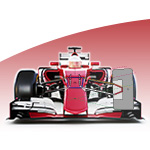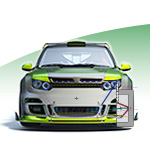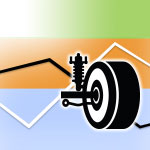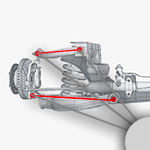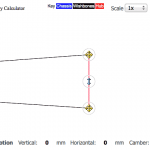About Negative Camber

We all hear about the importance of how negative camber helps performance driving, but do you know why and how much, if any, you need?
In a turn, your outer tires bear the brunt of the handling responsibility and they will tend to roll out/away from the car – this reduces the contact patch of the tire. The negative camber (which points the top of the wheel/tire into the car and the bottom edge away from the car) allows for a greater contact patch in these turns as the tire will roll into the patch.
Radial Tires
Radial tires benefit more from negative camber as the design produces a more flexible sidewall than, say, cross-ply tires. If you do not know what kind of tires you are using, you can probably assume you have radial tires.
Stuff
In Detail
Negative camber is the characteristic generally desired in performance driving. When we use the term, we’re referring to static negative camber. That is, the wheel and tire should exhibit some negative camber while sitting. When you enter a corner, the laws of physics have you, the wheels, and the tires pushed toward the outside of the corner. This is more noticeable when using radial tires due to the more flexible sidewall.
 When the wheels and tires are pushed outwards and the car’s body rolls, the contact patch, or the area of the tire which comes into contact with the surface of the road, diminishes significantly as it rolls over onto its outer shoulder.
When the wheels and tires are pushed outwards and the car’s body rolls, the contact patch, or the area of the tire which comes into contact with the surface of the road, diminishes significantly as it rolls over onto its outer shoulder.
Negative camber is implemented so that when the car is cornering and the wheel is rolling over and gaining positive camber, the negative camber should correct whatever effect leaning and lateral load have on the wheel and tire; resulting in the greatest possible contact patch.
Simply put, negative camber helps counteract the natural tendency for a tire to roll onto its outer shoulder while cornering, keeping the contact patch squarely on the road while cornering allow for more grip and higher cornering speeds.
Design Time
The Suspension Calculators allow you measure the amount of camber gain and correct it as necessary given any amount of body roll or bump and droop.
In the above example, to achieve 2.7 degrees of negative camber for the outside wheel at 3 degrees body roll, you will need 4 degrees of static negative camber.
At The Track
Determining what camber setting yields an evenly-applied contact patch can be done through measuring the heat at the inside, the center and the outside of the tire’s contact patch. By using a thermometer one can determine if one side of the tire is being worn more or less than the other. Generally speaking, the inside of the tire should be 10-15 degrees hotter than the outside. If the inside is exceedingly hot and wearing faster than the outside, there is too much negative camber. When this is present with the front wheels, the effect is diminished braking capability, poor turn-in and pronounced mid-corner understeer. When the rear tires exhibit too much negative camber, the effect is oversteer and a reduced ability to accelerate cleanly out of corners.
The opposite, excessive positive camber, shows up as a reversal of the aforementioned temperature spread. The outside is excessively hot and wears much faster than the inside of the tire. This leads to understeer mid-corner after the car has made its initial turn, and is usually the result of too much roll. It is because of this that excessive roll must be limited with anti-roll bars.
Subscribe

to the Suspension Geometry Calculator |

to the MacPherson Geometry Calculator |






